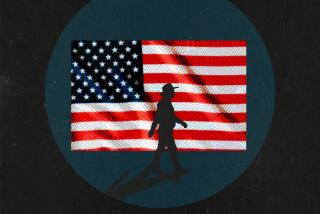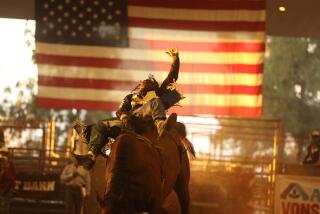Immigrants Set Out on Their Own Freedom Ride
The Rev. James Orange thought it had to be a joke. A new Freedom Ride
Orange, who earned his civil rights credentials in 1961 with a beating in a Birmingham, Ala., bus station, couldn’t imagine the idea of using one of the most storied moments in black history to promote the rights of immigrants, many of them undocumented. But after a few long nights of conversation with event organizers, the 60-year-old Atlanta minister started looking at things in a new way.
“When a worker is packed in the back of a truck and suffocates trying to get across the border, or when someone comes through the airport and gets detained just because his name is Abdullah, those are civil rights issues,” Orange said. “The rights we fought for in the ‘60s are the same rights people are fighting for now.”
With the endorsement of African American leaders such as Orange, immigrant workers across the nation are staging a new version of the Freedom Ride this week. The largest contingent, three full buses carrying 140 immigrant workers and their supporters, is scheduled to leave Los Angeles today.
One of their chief goals is to win legal status for millions of undocumented immigrants -- something the campaign hopes to do by linking the plight of immigrants with the struggles of the civil rights movement.
Organizers of the new Freedom Ride have won backing from key groups such as the National Assn. for the Advancement of Colored People and the Congressional Black Caucus, despite tensions between African Americans and undocumented workers who often are competing for the same jobs. Those behind the journey also face pointed criticism from some who find it hard to see any connection between today’s undocumented workers and the heroic Freedom Riders of the early ‘60s.
“Civil rights have nothing to do with the opening up of our borders,” said David Ray, associate director of the Federation for American Immigration Reform in Washington. “They are riding on the coattails of a completely different movement.”
Whatever the case, the organizers recognize that they have little chance of seeing quick success in Washington with their full agenda, especially at a time when the public is so concerned that an easing of restrictions at the border may be exploited by terrorists.
The original Freedom Ride was undertaken in May 1961, when scores of blacks and their white supporters rode buses across the South to challenge segregation. Violence ensued. One bus was firebombed, and riders were beaten.
The latest incarnation promises to be a far more peaceful affair. In all, 18 buses are departing from 10 cities on a route that will make more than 100 stops. Among them: Tucson, where riders will pay tribute to lost border crossers, and the Memphis, Tenn., hotel where Martin Luther King Jr. was shot.
All the participants will meet up in Washington for a rally and visit to Congress, and then converge on Oct. 4 at Flushing Meadows Park in New York, where organizers hope to draw 100,000 supporters to a closing ceremony.
The riders from Los Angeles include Maggie Larson, a Malaysian immigrant and hotel housekeeper who traveled from Hawaii; Mexican-born restaurant worker Rocio Rojas, who lives in L.A.; and Donte Woods, a 26-year-old African American activist with the Community Coalition, a South Los Angeles nonprofit.
Linking civil rights and immigrant rights is “a brilliant political strategy,” said Roger Waldinger, chairman of UCLA’s sociology department. “What they’re emphasizing is the humanity, that these are people just like you and me, and they deserve fundamental rights.”
The campaign was born two years ago at a brainstorming session by leaders of the hotel workers union, who were looking for ways to dramatize their push for immigration reform.
Since then, the ride has grown into something potentially much more significant as organizers have sought to redefine the quest for legalization by millions of undocumented immigrants, from Haiti to Nigeria to Mexico.
Along the way, the effort has become a significant moment in the relations between African Americans and undocumented immigrants, especially in places such as Southern California. As part of the preparations for the Freedom Ride, training sessions held during the last year have opened immigrants’ eyes to the sacrifices made by young black activists a generation ago.
“To see how badly they were treated -- one of the buses was even burned -- it gives you a lot to think about. There’s a lot to admire,” said 46-year-old Rojas, the restaurant worker. “It’s not exactly the same for us. We don’t have to go to the back of the bus. But still there is no respect at work, and we always, always live with fear.”
Proponents of the immigrants’ ride knew from the beginning that their idea had the potential to stir resentment.
Unlike African Americans battling for equality, after all, some of the immigrants on this latest trip entered the country and obtained jobs illegally -- sometimes competing for the same low-skilled jobs being sought by many blacks.
And so the ride’s advocates -- led by Maria Elena Durazo, president of Hotel Employees and Restaurant Employees Local 11 in Los Angeles -- spent months in private conversation with black leaders. “We wanted to be respectful,” she said. “We had a lot of one-on-one conversations. If, in the end, people thought it was wrong, we wouldn’t have done it.”
One of her first contacts was with the Rev. Jim Lawson, who had trained many of the original Freedom Riders in nonviolent resistance and was himself arrested in Jackson, Miss.
Lawson, 75, who is president of the Los Angeles chapter of the Southern Christian Leadership Conference, not only endorsed the ride; he became one of its leading advocates. Still, he concedes, his feelings aren’t universally shared.
“There are some feelings in the black community that immigrant workers are not a valid concern,” he said. “This is a beginning. It’s a step to launch a new conversation.”
Waldinger, the UCLA professor, agreed. Just because some black leaders have endorsed the immigrants’ Freedom Ride, he noted, it doesn’t necessarily mean that the community at large will be supportive.
“The leadership sees the broader issue, but the rank-and-file has more difficulty wrestling with two opposing feelings,” said Waldinger, who noted that there was strong support among blacks for California’s anti-illegal immigration measure, Proposition 187.
Sensitive to this reality, organizers are trying to use each of the 103 scheduled stops along the Freedom Ride to show that African Americans and immigrants share many of the same concerns. In Mississippi and North Carolina, for example, union organizers plan to tell riders that local employers -- a retailer and a hog processor -- are trying to leverage tensions, pitting one group against the other to avoid bargaining for a contract.
That pragmatic approach has persuaded some reluctant black unionists to endorse the ride. “Since they are here, they might as well have certain rights,” said Willie Robinson, president of the Coalition of Black Trade Unionists in Southern California. “It might eliminate them from being scabs.”
During the 50 or so hours of road time, riders will be immersed in civil rights history, with videos and lectures that try to make the link back to immigration issues. Buses will stop at all the major points of conflict in 1961, including the spots where a bus was run off the road and burned; the bridge where riders were met by a mob wielding pipes and baseball bats; and the Birmingham bus station where Orange was beaten as he tried to meet up with the original riders.
Meanwhile, advocates of tighter borders are planning a counter demonstration. That event is set for Oct. 3 at Liberty Park in New Jersey.
Times staff writer Teresa Watanabe contributed to this report.
More to Read
Sign up for Essential California
The most important California stories and recommendations in your inbox every morning.
You may occasionally receive promotional content from the Los Angeles Times.










